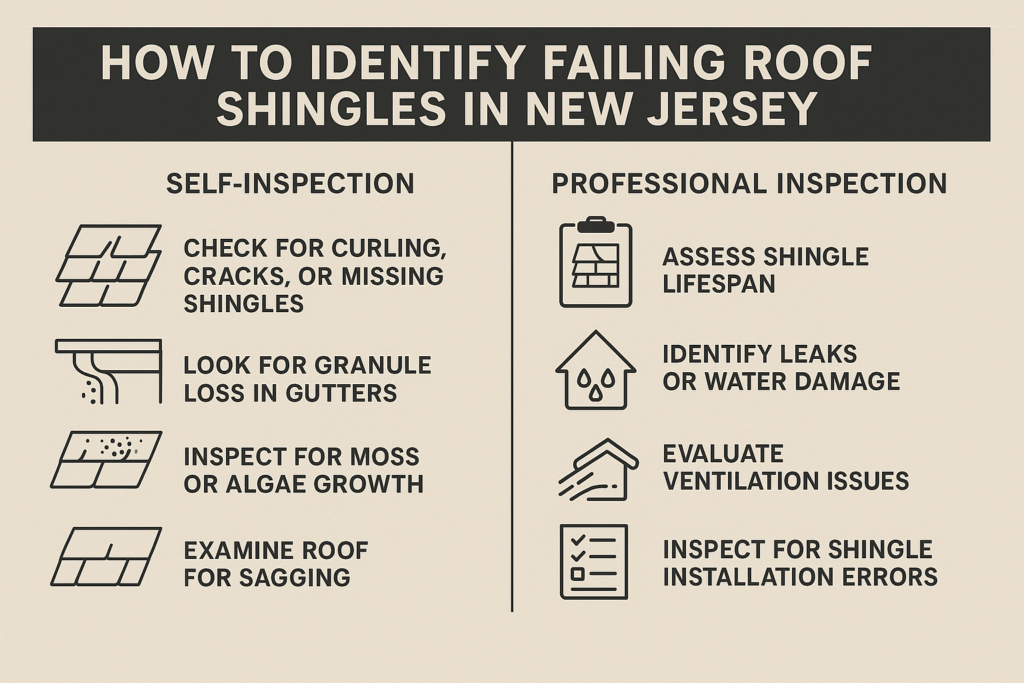How to Spot Failing Asphalt Roof Shingles in New Jersey: A Homeowner’s Guide
Asphalt shingles are the most common roofing material in New Jersey, thanks to their affordability and durability. But between snow, storms, humidity, and strong summer sun, NJ weather can wear shingles down faster than you might expect. Ignoring early signs of failure can lead to costly leaks, mold, or even structural damage.
This blog post will walk you through:
- The top visual and physical signs of failing shingles
- How New Jersey’s climate affects roof wear
- DIY roof inspection tips
- When to call a professional
Top Visual Signs of Failing Asphalt Shingles
Use binoculars or inspect from the ground safely:
- Curling or Buckling Shingles: Shingles curling at the edges or forming a wavy surface can mean heat damage, poor attic ventilation, or age-related wear.
- Missing Shingles: Gaps or torn-off shingles after windstorms create weak spots vulnerable to leaks.
- Granule Loss: Check gutters and downspouts for sand-like granules. Bald patches on shingles expose the roof to sun and water damage.
- Cracked or Brittle Shingles: Cracks, blisters, and brittle edges often indicate UV and thermal damage.
- Dark Streaks or Moss Growth: Algae, moss, and lichen flourish in NJ’s humid climate and indicate trapped moisture.
Physical Indicators of Roof Trouble
These signs often appear inside your home or attic:
- Water Stains: Brown spots on ceilings or walls are often caused by leaks.
- Musty Odors or Mold: Smells or visible mold in the attic point to poor ventilation or active leaks.
- Sagging Roof Lines: A drooping roof can mean structural damage or prolonged water infiltration.
- Light in the Attic: Daylight shining through means holes or damage to the decking.
- Shingle Debris in Gutters or Yard: Pieces of asphalt or whole shingles may appear after storms.
How NJ’s Climate Impacts Asphalt Roofs
- Winter: Ice dams can force water under shingles. Snow adds weight and moisture.
- Spring/Summer: Heat causes shingles to expand and contract, which may lead to cracking or blistering.
- Storms: High winds rip off weak shingles; hail can cause impact damage.
- Humidity: Encourages moss/algae growth, leading to decay over time.
DIY Roof Inspection Tips
- Inspect from the ground using binoculars after storms or every 6 months.
- Use a ladder carefully to inspect gutters and lower edges of shingles.
- Go into the attic with a flashlight to check for moisture, mold, or daylight.
- Take dated photos to track deterioration over time.
When to Call a Pro
- You see multiple missing or curling shingles
- Leaks, water stains, or mold are visible inside the home
- The roof is over 15 years old and hasn’t been inspected recently
- You experience a major storm or tree impact
- Ice dams recur every winter
A professional can do a full exterior and attic inspection, assess ventilation issues, use thermal imaging for hidden moisture, and recommend whether repairs or a full replacement are needed.
Final Thoughts
A failing roof often starts small. A lifted shingle here, some missing granules there. But over time, these minor issues grow into expensive problems. New Jersey homeowners should stay ahead of the weather and inspect their roofs regularly — and don’t wait until you have a leak to take action.
Need a roof inspection or repair in Monmouth County or surrounding areas? Contact Green Sun Energy Services today.


